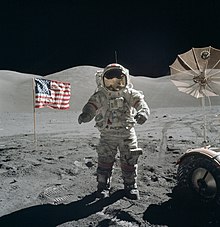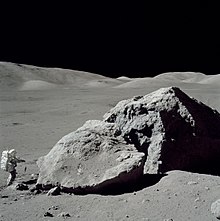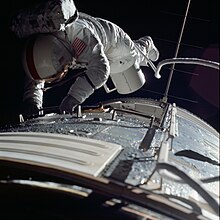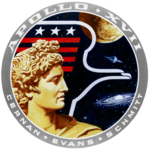એપોલો ૧૭
એપોલો ૧૭ એ નાસાનાં એપોલો અભિયાનની અગીયારમી સમાનવ અવકાશ યાત્રા હતી. તે અમેરિકાનું પ્રથમ સમાનવ રાત્રી પ્રક્ષે,પણ અને એપોલો અભિયાનનું છઠું અને છેલ્લું ચં , દ્ર પર ઉતરાણ માટેનું ઉડયન હતું. આ મિશન ૭/૧૨/૧ ૯૭૨ નાં રોજ રાત્રે ૧૨:૩૩ EST સમયે શરૂ થયું અને ૧૯/૧૨/૧૯૭૨ નાં સમાપ્ત થયું. જેણે સમાનવ ચંદ્ર પર ઉતરાણ અને સમાનવ નિમ્ન ભૂ-ભ્રમણકક્ષાની બહાર ઉડયન એમ બન્ને કામો પુરા કર્યા.
ચાલકદળ
[ફેરફાર કરો]કૌંસમાંનાં આંકડાઓ વ્યક્તિગત દરેકનાં આ મિશન અને આગલા અવકાશઉડાનનાં આંકડા દર્શાવે છે.
- યુગેને એ.સેર્નાન (Eugene A. Cernan) (૩) - કમાન્ડર/નિયંત્રક (Commander)
- રોનાલ્ડ ઇ.ઇવાન્સ (Ronald E. Evans) (૧) - નિયંત્રણ મોડ્યુલ ચાલક (Command Module Pilot)
- હૈરીસન એચ.સ્મિટ (Harrison H. Schmitt) (૧) - લુનાર મોડ્યુલ ચાલક (Lunar Module Pilot)
લુ.મો.ચા. તરીકે ખરેખરતો 'જો એન્જલ' (Joe Engle) પસંદ થયેલ, પરંતુ જ્યારે એ નક્કિ થઇ ગયું કે એપોલો ૧૭ છેલ્લું ચંદ્ર ઉડાન બનવાનું છે, તો વૈજ્ઞાનિક સમુદાયોએ નાસાને એક વૈજ્ઞાનિક અવકાશયાત્રીને ચંદ્ર પર ઉતરાણ માટે પસંદ કરવા દબાણ કર્યું. આને કારણે સ્મિટ,નિષ્ણાત ભૂ-વૈજ્ઞાનિકને તક મળી, અને તેને રદ કરાયેલ એપોલો ૧૮ ની ટુકડીમાંથી દુર કરી,એન્જલનાં સ્થાને એપોલો ૧૭ માં સમાવાયો.
સંરક્ષા ચાલકદળ (backup crew)
[ફેરફાર કરો]- જોહન યંગ (John Young) - કમાન્ડર/નિયંત્રક (Commander)
- સ્ટુઅર્ટ રૂસા (Stuart Roosa) - નિયંત્રણ મોડ્યુલ ચાલક (Command Module Pilot)
- ચાર્લસ ડ્યુક (Charles Duke) - લુનાર મોડ્યુલ ચાલક (Lunar Module Pilot)
આ મિશનનું મુળ સંરક્ષા ચાલકદળ એપોલો ૧૫નું મુખ્યચાલક દળ હતું:
- ડેવિડ સ્કોટ્ટ (David Scott) - કમાન્ડર/નિયંત્રક (Commander)
- આલ્ફ્રેડ વોર્ડન (Alfred Worden) - નિયંત્રણ મોડ્યુલ ચાલક (Command Module Pilot)
- જેમ્સ ઇરવિન (James Irwin) - લુનાર મોડ્યુલ ચાલક (Lunar Module Pilot)
The Apollo 15 prime crew received the backup assignment since this was to be the last lunar mission and the backup crew would not rotate to another mission. However, when the Apollo 15 postage stamp incident became public in early 1972 the crew was reprimanded by NASA and the Air Force (they were active duty officers). Director of Flight Crew Operations Deke Slayton removed them from flight status and replaced them with Young and Duke from the Apollo 16 prime crew and Roosa from the Apollo 14 prime and Apollo 16 backup crews.[૧]
સહાયક ચાલકદળ
[ફેરફાર કરો]- રોબર્ટ એફ.ઓવરમ્યેર (Robert F. Overmyer)
- રોબર્ટ એ.પાર્કર (Robert A. Parker)
- સી.ગોર્ડન ફુલરટોન (C. Gordon Fullerton)
મિશન પ્રાચલો
[ફેરફાર કરો]- દળ:
- પ્રક્ષેપણ દળ: ૬,૪૫૫,૦૦૦ lb (૨,૯૨૩,૪૦૦ કિ.ગ્રા.)
- કુલ અવકાશયાન: ૧૦૨,૯૦૦ lb (૪૬,૭૦૦ કિ.ગ્રા.)
- CSM દળ: ૬૬,૮૪૦ lb (૩૦,૩૨૦ કિ.ગ્રા.), જેમાંથી CM નું ૧૩,૧૪૦ lb (૫૯૬૦ કિ.ગ્રા.), SM ૫૩,૭૦૦ lb (૨૪,૩૬૦ કિ.ગ્રા.)
- LM દળ: સ્થાનાંતરણ અને જોડાણ તબક્કો ૩૬,૨૭૪ lb (૧૬,૪૫૪ કિ.ગ્રા.), ચંદ્ર પર ઉતરાણ માટે અલગ પડતી વખતે ૩૬,૭૭૧ lb (૧૬,૬૭૯ કિ.ગ્રા.), ચંદ્ર પરથી ફરી આરોહણનો તબક્કો ૧૦,૯૯૭ lb (૪,૯૮૮ કિ.ગ્રા.)
- પૃથ્વીની કક્ષાઓ (પ્રદક્ષિણા): ૨ ચંદ્ર પર જતી વખતે, લગભગ એક પરત આવતી વખતે.
- ચંદ્રની કક્ષાઓ (પ્રદક્ષિણા): ૭૫
- ભૂ-સમીપક (Perigee): ૧૦૪.૯ માઇલ (૧૬૮.૯ કિ.મી.)
- ભૂ-દુરીય Apogee): ૧૦૬.૪ માઇલ (૧૭૧.૩ કિ.મી.)
- ઝુકાવ (Inclination): ૨૮.૫૨૬°
- પરિભ્રમણ કાળ (Orbital period): ૮૭.૮૩ મીનીટ
- ચંદ્ર-સમીપક (Perilune): ૬૦.૫ માઇલ (૯૭.૪ કિ.મી.)
- ચંદ્ર-દુરીય (Apolune): ૧૯૫.૬ માઇલ (૩૧૪.૮ કિ.મી.)
- ઝુકાવ (Inclination): ૧૫૯.૯°
- પરિભ્રમણ કાળ (Orbital period): અંદાજે ૧૨૦ મીનીટ
- ઉતરાણ સ્થળ: 20.19080° N - 30.77168° E કે
20° 11' 26.88" N - 30.1° 46' 18.05" E
જોડાણ
[ફેરફાર કરો]- Undocked: ડિસેમ્બર ૧૧, ૧૯૭૨ - ૧૭:૨૦:૫૬ UTC
- Docked: ડિસેમ્બર ૧૫, ૧૯૭૨ - ૦૧:૧૦:૧૫ UTC
ઇ.વિ.એ. (EVAs)(Extra-vehicular activity)
[ફેરફાર કરો]ઇ.વિ.એ. નો અર્થ "અતિરિક્ત વાહનીય ગતિવિધિ" (Extra-vehicular activity) એવો થાય છે, અર્થાત ચંદ્રભૂમિ પર વાહન લઇ અને પ્રયોગાર્થે જે પરિભ્રમણ કરેલ હોય તેની વિગતો અહીં આપવામાં આવેલ છે.

- સર્નાન અને સ્મિટ - EVA ૧
- EVA ૧ શરૂ: ડિસેમ્બર ૧૧, ૧૯૭૨, ૨૩:૫૪:૪૯ UTC
- EVA ૧ અંત: ડિસેમ્બર ૧૨, ૦૭:૦૬:૪૨ UTC
- સમયગાળો: ૭ કલાક, ૧૧ મીનીટ, ૫૩ સેકન્ડ
- સર્નાન અને સ્મિટ - EVA ૨
- EVA ૨ શરૂ: ડિસેમ્બર ૧૨, ૧૯૭૨, ૨૩:૨૮:૦૬ UTC
- EVA ૨ અંત: ડિસેમ્બર ૧૩, ૦૭:૦૫:૦૨ UTC
- સમયગાળો: ૭ કલાક, ૩૬ મીનીટ, ૫૬ સેકન્ડ
- સર્નાન અને સ્મિટ - EVA ૩
- EVA ૩ શરૂ: ડિસેમ્બર ૧૩, ૧૯૭૨, ૨૨:૨૫:૪૮ UTC
- EVA ૩ અંત: ડિસેમ્બર ૧૪ ૦૫:૪૦:૫૬ UTC
- સમયગાળો: ૭ કલાક, ૧૫ મીનીટ, ૦૮ સેકન્ડ
- ઇવાન્સ (સ્મિટ - સ્ટેન્ડ અપ) - ટ્રાન્સઅર્થ EVA ૪
- EVA ૪ શરૂ: ડિસેમ્બર ૧૭, ૧૯૭૨, ૨૦:૨૭:૪૦ UTC
- EVA ૪ અંત: ડિસેમ્બર ૧૭, ૨૧:૩૩:૨૪ UTC
- સમયગાળો: ૧ કલાક, ૦૫ મીનીટ, ૪૪ સેકન્ડ
યાનનું ઉતરાણ બિંદુ ૧૭° ૫૨′ દક્ષિણ, ૧૬૬° ૭′ પશ્ચિમ , સોલોમન ટાપુઓની ૩૫૦ દરિયાઇ માઇલ (૬૫૦ કિ.મી.) દ.પૂ. અને બચાવ જહાજ 'યુ.એસ.એસ.ટિકોન્ડેરોગા' (USS Ticonderoga (CV-14)) થી ૬.૫ કિ.મી. દુર હતું. એપોલો ૧૭ તેનાં લક્ષ્ય બિંદુથી લગભગ ૬૪૦ મીટર દુર ઉતર્યુ હતું.
મિશનનું મુખ્ય આકર્ષણ
[ફેરફાર કરો]





ચંદ્ર પર પગ મૂકનારા છેલ્લા બે માણસોમાંના એક પ્રથમ વૈજ્ઞાનિક-અવકાશયાત્રી, ભૂસ્તરશાસ્ત્રી હેરિસન ("જેક") શ્મિટ પણ હતા. જ્યારે ઇવાન્સે અમેરિકામાં ચક્કર લગાવ્યા, ત્યારે શ્મિટ અને સેર્નને ત્રણ મૂનવોક દરમિયાન રેકોર્ડ 109 કિગ્રા (240 પાઉન્ડ) ખડકો એકત્રિત કર્યા. ક્રૂએ તેમના રોવરમાં વૃષભ-લિટ્રો ખીણમાંથી 34 કિમી (21 માઇલ) સુધી ભ્રમણ કર્યું, નારંગી રંગની માટી શોધી, અને ચંદ્રની સપાટી પર એએલએસઇપીમાં સાધનોનો સૌથી વ્યાપક સેટ છોડી દીધો. એપોલો ચંદ્ર ઉતરાણ મિશનમાં તેમનું મિશન છેલ્લું હતું. છેલ્લી 4 એપોલો હસ્તકલાનો ઉપયોગ 1975માં ત્રણ સ્કાયલેબ મિશન અને ASTP મિશન માટે કરવામાં આવ્યો હતો.
પરિચય
[ફેરફાર કરો]ક્રૂ સભ્યો યુજેન સેર્નન, કમાન્ડર હતા; રોન ઇવાન્સ, કમાન્ડ મોડ્યુલ પાઇલટ; અને હેરિસન શ્મિટ, ચંદ્ર મોડ્યુલ પાઇલટ.
આ મિશન માટે ઉતરાણ સ્થળ દક્ષિણપશ્ચિમ મોન્ટેસ વૃષભમાં મેર સેરેનિટાટીસની દક્ષિણપૂર્વ કિનાર પર હતું. વૃષભ-લિટ્રો પ્રદેશ તરીકે ઓળખાતા વિસ્તારમાં આ ત્રણ ઊંચા, ઢાળવાળા માસિફ્સ વચ્ચેનો ઘેરો આવરણ હતો. પ્રી-મિશન ફોટોગ્રાફ્સમાં પહાડોના પાયા સાથે જમા થયેલ પથ્થરો દર્શાવવામાં આવ્યા હતા, જે બેડરોક નમૂનાઓ આપી શકે છે. આ વિસ્તારમાં ભૂસ્ખલન, કેટલાક પ્રભાવિત ખાડાઓ અને કેટલાક ઘાટા ખાડાઓ પણ છે જે જ્વાળામુખી હોઈ શકે છે.
જે-ક્લાસ મિશન, જેમાં લુનર રોવર દર્શાવવામાં આવ્યું હતું, તેઓએ ત્રણ ચંદ્ર સપાટી પર્યટન કર્યું, જે 7.2, 7.6 અને 7.3 કલાક ચાલ્યું. મિશને ચંદ્રમાંથી 110.5 કિગ્રા (243.6 lb) નમૂના પરત કર્યા.
આ મિશન પર અવકાશયાત્રીઓએ "ધ બ્લુ માર્બલ" તરીકે ઓળખાતી પૃથ્વીનો પ્રખ્યાત ફોટોગ્રાફ લીધો, જે લગભગ સમગ્ર આફ્રિકા ખંડ અને એન્ટાર્કટિકા ખંડ દર્શાવે છે. ચંદ્રની ભ્રમણકક્ષાના નિવેશ પછી તરત જ પૃથ્વીનો ફોટોગ્રાફ લેનાર અન્ય ચંદ્ર ઉતરાણ મિશનમાં પશ્ચિમ ગોળાર્ધ દર્શાવવામાં આવ્યો હતો.
મિશન નોંધ
[ફેરફાર કરો]
- Schmitt, a geologist, was the first (and to date, only) scientist to walk on the Moon.
- Like the astronauts of Apollo 10, 12, 13, and 14 before them, the Apollo 17 crew were recovered in Pacific waters near American Samoa after splashdown, and were flown from the recovery ship to the airport at Tafuna where they were greeted with an enthusiastic (and well practiced) Samoan reception before being flown on to Honolulu, thence to Houston.
- The plaque left on the ladder of the descent stage of Challenger read: Here Man completed his first explorations of the moon. December 1972 AD. May the spirit of peace in which we came be reflected in the lives of all mankind. The plaque showed two hemispheres of Earth and the near side of the Moon, plus the signatures of Cernan, Evans, Schmitt, and President Nixon.
- Commander Eugene Cernan took a Czechoslovak flag with him to the Moon because his ancestors came from Czechoslovakia. Later he gave it to the Institute of astronomy in Ondrejov (Czech Republic).
- Schmitt was originally due to fly on the cancelled Apollo 18 but following pressure from the science community was moved up to LM pilot on Apollo 17 in place of Joe Engle.
- Apollo 17 broke several records set by previous flights, including longest manned lunar landing flight; longest total lunar surface extravehicular activities; largest lunar sample return, and longest time in lunar orbit.
- Apollo 17 was the last manned NASA mission to land on the moon. The next crewed NASA mission to land on the Moon is very tentatively scheduled to occur in 2019 with the Orion 15 mission.
અવતરણો
[ફેરફાર કરો]"Ah! You see one Earth, you've seen them all."
- – Jack Schmitt, Lunar Module Pilot.
"As I take man's last step from the surface, back home for some time to come — but we believe not too long into the future — I'd like to just [say] what I believe history will record — that America's challenge of today has forged man's destiny of tomorrow. And, as we leave the Moon at Taurus-Littrow, we leave as we came and, God willing, as we shall return, with peace and hope for all mankind. Godspeed the crew of Apollo 17."
- – Eugene A. Cernan, Apollo 17 Commander. Last man to walk on the moon, December 14, 1972.
મિશનનું નિશાન (ચિહ્ન)
[ફેરફાર કરો]
The circular patch is one of the most detailed of the Apollo series. The official NASA press release said: "The insignia is dominated by the image of Apollo, the Greek sun god. Suspended in space behind the head of Apollo is an American eagle of contemporary design, the red bars of the eagle's wing represent the bars in the U.S. flag; the three white stars symbolize the three astronaut crewmen. The background is deep blue space and within it are the Moon, the planet Saturn and a spiral galaxy or nebula. The Moon is partially overlaid by the eagle's wing suggesting that this is a celestial body that man has visited and in that sense conquered. The thrust of the eagle and the gaze of Apollo to the right and toward Saturn and the galaxy is meant to imply that man's goals in space will someday include the planets and perhaps the stars. The colors of the emblem are red, white and blue, the colors of the U.S. flag; with the addition of gold, to symbolize the golden age of space flight that will begin with this Apollo 17 lunar landing. The Apollo image used in this emblem was the Apollo of Belvedere sculpture now in the Vatican Gallery in Rome. This emblem was designed by artist Robert T. McCall in collaboration with the astronauts." The insignia is surrounded by a light gray band with names of the crew and the words APOLLO XVII.
અવકાશયાનનું સ્થાન
[ફેરફાર કરો]નિયંત્રણ મોડ્યુલ (Command Module) અમેરિકા હાલમાં 'સ્પેશ સેન્ટર હ્યુસ્ટન'en:Space Center Houston, હ્યુસ્ટન, ટેક્ષાસ ખાતે જોવા મળે છે.
લુનાર મોડ્યુલ (Lunar Module) ચેલેન્જર ડિસેમ્બર ૧૫,૧૯૭૨ નાં રોજ ૦૬:૫૦:૨૦.૮ UT (૧:૫૦ AM EST)(?? IST) સમયે ચંદ્ર પર ૧૯.૯૬ N, ૩૦.૫૦ E સ્થળે ઉતારવામાં આવ્યું.
ચલચિત્ર
[ફેરફાર કરો]-
અવકાશ યાત્રી હૈરીસન સ્મિટ (Harrison Schmitt) મૂનવોક (ચંદ્ર પર ચાલવું) વખતે.
-
હૈરીસન સ્મિટ ગીત ગાય છે. "હું એક દિવસ ચંદ્ર પર ફરીશ" (I was strolling on the Moon one day)
-
એપોલો ૧૭ નું ચંદ્રયાન (Lunar Module) ધડાકા સાથે પ્રજ્જવલીત થઇ અને ચંદ્રને ત્યજે છે.
કલ્પના ચિત્રણ
[ફેરફાર કરો]Portions of the Apollo 17 mission are dramatized in the miniseries From the Earth to the Moon episode entitled "Le Voyage dans la Lune".
The novel Tyrannosaur Canyon by Douglas Preston opens with a depiction of the Apollo 17 moonwalks using quotes taken from the official mission transcript.
Additionally, there have been fictional astronauts in film, literature and television who have been described as "the last man to walk on the moon," implying they were crew members on Apollo 17. One such character was Steve Austin in the television series The Six Million Dollar Man. In the 1972 novel Cyborg, upon which the series was based, Austin remembers watching the Earth "fall away during Apollo XVII." [૩] In an episode of the series, Austin clearly states that he flew on "Apollo 17". Another example is the character of Captain Tanner in the science fiction film Deep Impact.
The mission patch for Apollo 17 was used for the mission patch for the NASA space ship Charybdis in an episode of "Star Trek: The Next Generation" entitled "The Royale".
In WALL-E, the main characters flying away from Earth pass the Moon and the landing site of Apollo 17 (or perhaps one of the other "J" missions: Apollo 15 and 16). Behind the landing site one sees a large sign on the lunar surface exclaiming the future site of a shopping mall.
આ પણ જુઓ
[ફેરફાર કરો]સંદર્ભ
[ફેરફાર કરો]- ↑ Donald K. Slayton, "Deke!" (New York: Forge, 1994), 279
- ↑ "Portfolio from Apollo - TIME". મૂળ માંથી 2013-08-17 પર સંગ્રહિત. મેળવેલ 2009-02-22.
- ↑ Caidin, Martin: Cyborg, page 15. Warner Paperback Library, 1972.
- NASA NSSDC Master Catalog સંગ્રહિત ૨૦૦૭-૧૦-૦૨ ના રોજ વેબેક મશિન
- Apollo 17 Info by NASA
- Apollo by the numbers: A Statistical Reference by Richard W. Orloff (NASA) સંગ્રહિત ૨૦૨૧-૦૪-૧૭ ના રોજ વેબેક મશિન
- Development of Manned Space Flight, American and Soviet NASA SP-4209 સંગ્રહિત ૨૦૨૧-૦૪-૧૦ ના રોજ વેબેક મશિન
- The Apollo Spacecraft: A Chronology સંગ્રહિત ૨૦૧૭-૧૨-૦૯ ના રોજ વેબેક મશિન
- Apollo Program Summary Report સંગ્રહિત ૨૦૦૬-૦૯-૨૯ ના રોજ વેબેક મશિન
- Apollo 17 Characteristics - SP-4012 NASA historical data book સંગ્રહિત ૨૦૨૧-૦૪-૧૦ ના રોજ વેબેક મશિન
- Apollo 17 entry at Apollo Lunar Surface Journal સંગ્રહિત ૨૦૧૪-૦૧-૦૪ ના રોજ વેબેક મશિન - Provides an extensive insight of the mission, along with full transcripts and detailed interviews with the crewmembers.
- Lattimer, Dick (1985). 'All We Did was Fly to the Moon. Whispering Eagle Press. ISBN 0-9611228-0-3.
બાહ્ય કડીઓ
[ફેરફાર કરો]- Apollo 17 - entry in Encyclopedia Astronautica
- Apollo 17 - Final Reflections on Apollo સંગ્રહિત ૨૦૧૪-૦૭-૦૬ ના રોજ વેબેક મશિન Video as the crew wraps up the final Apollo mission
- Apollo 17 - Science Experiments
- Apollo 17 - Voice Transcript Pertaining to the Geology of the Landing Site
- Apollo landing Locations at Google Moon
- Apollo Lunar Surface VR Panoramas QTVR panoramas
- Apollo simulation for Orbiter spaceflight sim
- September 1973 National Geographic Magazine article સંગ્રહિત ૨૦૦૭-૧૦-૨૨ ના રોજ વેબેક મશિન
- Transcript of lifting off from the Moon સંગ્રહિત ૨૦૨૧-૦૪-૧૦ ના રોજ વેબેક મશિન
- Apollo 17 television transmissions ApolloTV.net Video
